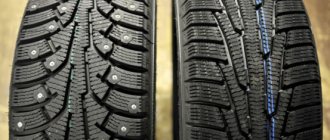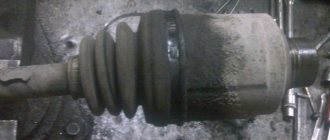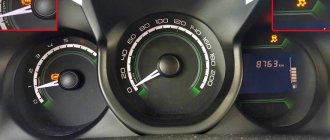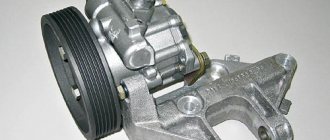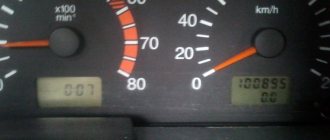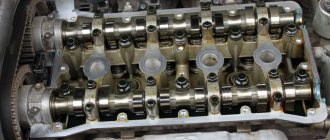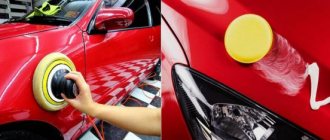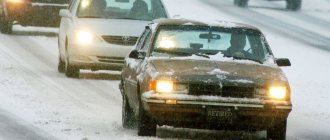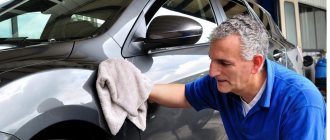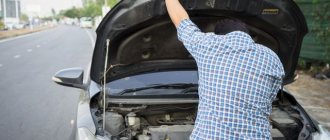There are a number of malfunctions that inevitably arise during the operation of any vehicle. A common problem is that the car pulls to the side when driving smoothly in a straight line. The problem manifests itself in different ways: in one case the car pulls strongly to the left (or right), in the second it pulls slightly on a hard road surface, in the third it skids when braking. To eliminate this dangerous phenomenon, it is necessary to find out the reasons for this behavior of the car.
Why does the car deviate from a straight line?
When the car does not want to move straight, the ride becomes uncomfortable - the driver has to constantly steer, and in some situations actually keep the car from drifting. You can’t relax - you’ll end up in a ditch or have a head-on collision with an oncoming car. It is better not to delay in finding out the cause of the problem.
Spontaneous movement of the machine from a straight path may be a sign of the following problems:
- The pressure in the front tires is very different;
- uneven wear of the front wheel treads;
- faulty steering parts;
- problems with the front suspension and chassis;
- malfunctions of the brake mechanisms.
Before looking for the cause, it is advisable to make sure that the car actually pulls to the side when you let go of the steering wheel. Example: When driving on unpaved and poorly paved roads with ruts, the wheels tend to follow the path of least resistance and are reluctant to leave the grooves. Carry out the test on a flat piece of road surface.
The bulk of the listed problems occur during the acceleration and forward movement of the car. Brake malfunctions are immediately noticeable: the car drifts when slowing down. The more intense the braking, the more the car deviates from the straight line, and the driver has to turn the steering wheel more to keep the vehicle on the desired trajectory.
This is why your car may pull to the left or to the right.
Does your car pull to the left or to the right? If you find it difficult to control your car while driving, then it is likely that it has problems. Yes, of course, the car can be pulled to the side due to the slope of the road towards the side of the road or due to the quality of the road surface. But in most cases, this sign indicates possible problems with the car.
There are many reasons that can cause a car to pull to the side. You can find out about these reasons in our article, which will help you determine the source of this problem based on various signs.
Tire problems
The pressure difference in the front wheel cylinders is the most common reason for a car to easily pull away while driving. Diagnosis could not be easier - just measure the pressure with a pressure gauge and, if necessary, pump up the sagging slope. If the car pulls to the right, then low pressure should be observed in the right wheel and vice versa. Otherwise, you need to look for the problem elsewhere.
Equally common is uneven wear of the rubber on the wheels of the front axle. The reasons for the phenomenon are:
- a car enthusiast rarely monitors tire pressure;
- the wheels have not undergone the balancing procedure;
- in front there are tires with different patterns and sizes;
- slopes with a directional pattern are installed incorrectly;
- long driving with unadjusted camber angles of the front wheels.
Rubber of varying degrees of wear often ends up on one axle as a result of seasonal replacement. The owner of the “iron horse” did not mark the removed wheels according to their installation locations and next time he put them on at random. As a result, the rear and front axle tires got mixed up.
Reference. On front-wheel drive cars, the front slopes wear out much faster than the rear ones. If the wheels are mixed up and placed on one axle, the car will begin to pull towards a lower tread.
How to solve the problem of unevenly worn rubber:
- Choose a tire with high tread instead of a worn wheel. For example, install a spare tire.
- Balance the wheels, check and adjust the camber angles. Continuing operation and waiting for the differential to complete its task will increase the load on a tire of a larger diameter, causing the tread to quickly wear out.
- Place the rear slopes forward.
Avoiding the above-described manipulations is quite simple - pump up the cylinders in a timely manner, carry out balancing at intervals of 5 thousand km and visit the camber stand every 10-15 thousand km or after a strong blow to the suspension.
Wheel alignment
Difficulty in driving a car or deviation of the steering wheel from direct movement can be caused by incorrectly adjusted wheel alignment.
This is especially true in cases where the camber angle is positive on one rear wheel and negative on the other. The main visible consequence of this phenomenon will be uneven tire wear and deterioration in handling.
To correct the situation, it is important to first carry out a comprehensive repair of the chassis, and then begin adjusting the wheel alignment. Modern automobile workshops offer computer diagnostics of the wheel alignment angle on a special stand with subsequent correction of the situation in accordance with the standards.
See also:
Car vibrations: signs, causes and solution to the problem
Chassis and suspension malfunctions
When mechanical problems occur, the car pulls to the side much more than from the difference in tire pressure or different tread heights. The following faults cause the vehicle to be driven away:
- Worn tie rod ends. The ball pin does not turn well in the hinge, and sometimes it simply jams. A clear sign is that the steering wheel does not return to its original position on its own, the car continues to move in an arc.
- One of the steering rods was bent as a result of the impact and became several millimeters shorter. The toe angle of the front wheels is disrupted, tire wear on the affected side is accelerated, and the car is driven in the appropriate direction.
- The ball joint is stuck. The pin rotates around its own axis with great difficulty and does not allow the wheels to turn freely. At the last stage of wear, the hinge emits a loud creaking sound - a harbinger of final failure.
- The separator of one of the wheel bearings is destroyed. The balls scattered and ground into metal shavings, blocking the rotation of the hub. The car pulls towards the jammed wheel.
- After repairing the suspension, the alignment procedure was performed incorrectly or not done at all.
Advice. Not all reasons for a vehicle's deviation from a straight line are so critical. More prosaic moments also happen, for example, the bolts holding the hub have come loose. Hence the recommendation: before troubleshooting, check the reliability of the threaded connections of the suspension, chassis and steering rods.
How to diagnose these faults in a garage environment:
- Drive the car into an inspection ditch and check the steering rod ball pins. You need to grab the rod with your hand and try to rotate it around its axis. A serviceable hinge will allow it to rotate with little tension, a loose one will allow it to rotate very easily, and a jammed one will not allow it to rotate at all.
- The bent rod is also easy to notice from the inspection hole. The part must be replaced immediately, you can drive further only after adjusting the camber.
- To check the rotation of the ball joint, it is advisable to hang the front of the car and turn the wheels manually. Option two: diagnose play by alternately rocking the wheels.
- Wear and destruction of the bearing does not occur silently - the phenomenon is accompanied by a hum and grinding noise while the vehicle is moving. To check for damage, hang the wheel from the “noisy” side and spin it by hand. A broken bearing will immediately stop rotating or start grinding.
The bearing, which is in the initial stages of wear, moves the machine off the trajectory slightly. It is easier to guess about a malfunction by the buzzing sound. The damaged element is replaced immediately at the nearest car service center or on your own. If after replacement the car continues to deviate from a straight line, look for a breakdown elsewhere.
You can replace the rods and steering ends yourself (you will need a special puller), but you cannot drive further without adjusting the toe on the stand. By squeezing out the ball pins or unscrewing the tips, you will inevitably break the old settings.
Steering wheel pulls when accelerating
When spontaneous movement of the steering wheel to the right or left is observed only when accelerating, it is recommended to begin troubleshooting from the following points:
- Checking tire pressure;
- High-quality wheel alignment;
- Inspect the tires for damage or differences in tire wear on one axle.
In rare situations, the steering wheel pulls to the side during acceleration due to serious problems in the steering mechanisms or play.
Related Posts
The steering wheel does not return to its original position
The speaker wheezes in the car: diagnosis and solution to the problem
Why the clutch slips: diagnostics and main faults
- Peugeot
- Car accessories
- Battery
- Knowledge base
- VAZ
- Generator
- Sensors Oil pressure sensor
- Mass air flow sensor
- Shock sensors
- Other sensors
- Engine
- Automatic
- Brake lights
- Indicators
- Antifreeze
- Gas tank
- Engine
#OkayDrive © 2021 A car is simple, and we will prove it. Articles on car repair and operation, as well as useful tips for car enthusiasts.
Unauthorized use of materials posted on the site is prohibited by copyright law. Using materials reference to the site is obligatory. Cookie Policy Personal Data Processing Policy
Brake problems
Problems with brake mechanisms appear both after pressing the pedal and while driving. The reasons are as follows:
- complete failure of one of the working cylinders, including on the rear axle;
- jamming of the working cylinder piston in various positions;
- fluid leakage from the brake circuit tube;
- failure of the hydraulic valve of the anti-lock braking system.
When the working cylinder on one of the front wheels fails, the car literally rolls away after sharply pressing the brake. If the car pulls to the left, it means the right cylinder is not functioning and vice versa. When the brake cylinder of the rear axle fails, the car does not pull away so clearly. The easiest way to find the “culprit” is by leaking brake fluid, inspecting each hub from an inspection ditch or simply looking under the car.
On cars with high mileage and worn calipers, the piston of the working cylinder may become stuck in the position of squeezing the pads. The wheel on the side of the faulty mechanism is continuously braked, and the car constantly moves in the same direction. It is easy to identify a breakdown: after driving 1–2 km, feel all the wheel rims with your hand. The “culprit” will be revealed by the heated rim.
If the piston of the working cylinder is frozen in a free position, then the vehicle will drift during the braking process - the car will drift in the direction opposite to the non-working mechanism. To finally make sure that the element is broken, hang the wheel from the suspicious side and try to spin it with the brake pedal pressed.
Diagnosing anti-lock braking system (ABS) problems in a garage environment is difficult. If fluid does not pass through one of the valves, you will have to disassemble the calipers and make sure that the cylinders are functioning normally. It’s easier to go to the nearest car service center, where technicians will check the brakes using specialized equipment.
Damaged tire
This is already a more significant reason. Tires tend to wear out only partially. Therefore, the stability of the movement of the steered wheels may be lost. It is necessary to carefully check the condition of all tires. If it is not possible to replace damaged rubber, you can turn them over with the smoother side out. This is a way to restore driving stability to the car, and also save on replacing tires. But you need to remember that this can only help for a short time. The tires will still have to be changed.
Rear brake adjuster
The rear wheel brake assembly can also fail when the brake adjuster becomes stuck or fails. Brake shoe adjusters must maintain the correct distance between the brake shoe linings and the drum as the linings wear. Most vehicles use a sprocket (screw) type mechanism for the adjuster, while some modern vehicles may use a latch type mechanism for the adjuster.
- Raise and securely support the vehicle on a stand.
- Remove the wheel and drum.
- Check for free movement of the regulator.
- Consult the repair manual for your specific vehicle model to repair or replace the regulator if necessary.
Faulty tire and belt layers can also cause the brakes to stretch.
Reason #6. Wheel bearings
When the wheel bearings wear out, the wheels begin to rotate on the hub with chaotic deviations. It is quite clear that in such situations the car should not drive smoothly. Depending on the degree of wear of the bearings, one or another wheel may wobble so much that it is difficult to keep the car on the road.
You can first identify faulty wheel bearings yourself. To do this, it is enough to hang the wheels one by one using a standard jack and act on them in different directions. If there are any noticeable plays, it means the bearings have already been “broken” and it’s time to change them.
Reason #10. Body geometry
This is perhaps the saddest reason why a car pulls to the side. Violation of body geometry, even if it is not visible during visual inspection, significantly affects the straightness and controllability of the car. This happens not only as a result of an accident or after inept body repair. The geometry of the body can easily be disrupted even after hitting a serious hole or other similar obstacle. Moreover, modern cars are not made of particularly thick metal, which in some places bends when pressed with a finger.
It is impossible to determine a violation of the body geometry on your own, if it is small. To do this, you need special equipment to measure the distances between the so-called control points of the car. The obtained data is verified against the control point map provided by the manufacturer of a particular model. By the way, body repairs after an accident should also be carried out using such equipment, and using such maps, and not “by eye”.
